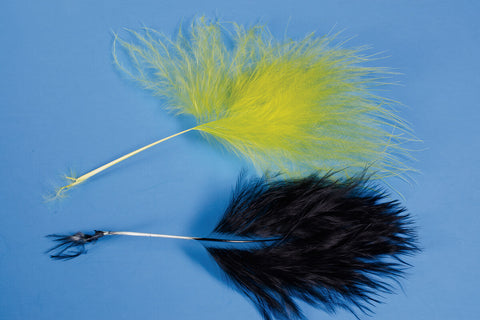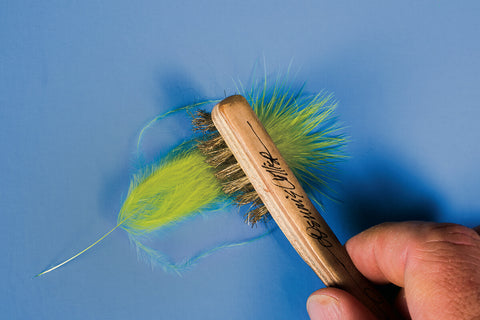It is often assumed that I, as a fly shop owner and all-around big-shot fly tier guy, get preferential treatment by suppliers, and receive only the highest grade materials for my personal use. The reality is, I buy my materials straight off the wall of my shop, from the same suppliers nearly everyone else uses. But that doesn’t mean my flies are destined to be average.
All flies are made up of the sum of their parts and it doesn’t take many years of tying to figure out that material selection and preparation are keys to producing exceptional flies. I’m often asked what I look for when I sort through patches of hair, dry-fly capes, and other materials, and I have written extensively about those natural fibers. But proper preparation and selection shouldn’t end there; it’s critically important with every type of natural material where genetic and environmental variances play a huge role in the end product.
A great case in point here is common marabou. One of the most popular tying materials, marabou feathers are the soft, downy feathers along the bottom of a common domestic turkey. These feathers come in two basic types that can be referred to as the “stiff stuff” and the “silky stuff.”

The stiff stuff is blood quill marabou. It isn’t actually all that stiff, but is characterized by its longer length with thinner barbs and barbules radiating from a thin, pliable center stem.

Blood quill marabou is the most common type and is useful for a bunch of different tying applications, particularly those involving wrapping the whole feather. The thin stem wraps easily around a hook shank, and the fibers radiate from the shank like hackle. The stiffer fibers of blood quill marabou also hold their shape better, so I also use it for stacked tails and wings in many of my flies.
Large blood quill marabou feathers are often sold as “extra select marabou” and these bigger feathers tend to have much thicker stems, particularly toward the butts. Regular blood quill marabou seems to do the job better for me in most instances, with far less trouble.
Silky marabou, often sold as Woolly Bugger marabou, is shorter overall with shorter barbs but longer, softer barbules. Woolly Bugger marabou is limp when dry, and has tremendous action in the water. This marabou also has a thicker stem that precludes it from being wrapped like a hackle feather.
As the name implies, this is the perfect material for tails on Woolly Buggers and many other variant streamer patterns like the Gonga. As a bonus, you can tear the soft, thick barbules to length with your thumbnail rather than leaving a clipped-off, right-angle edge with scissors.
After you purchase your marabou, you still need to do some preparation work before you can use it. The first thing I do with a new pack of marabou is open it up and pull everything out.
Typically, marabou is sold “strung,” which means the butt ends of the feathers are sewn together into a neatly aligned bundle. This is to keep the feathers together during the dying process, and makes for neater packaging.
I clip that string about every inch along the length of the bundle to remove the tension and allow the feathers to separate. Then I pull every feather from the binding and make stacks of whole, usable feathers without broken tips or scraggly fibers. The rejected stuff goes into the trash.

Next, I wash and dry the feathers. When I first started tying, marabou was processed much more thoroughly than it is now, but in these days of cutting corners, the air-dried stuff we buy is not rinsed thoroughly after dying, and it is often matted, clumped, and ratty. If you want to make neat, beautiful flies, you’ll need to wash, rinse, and dry.

I align the butt ends of my selected feathers and bind them with a length of heavy copper wire. Then I run them under hot water in the sink with a few drops of liquid dish soap to saturate them. After a good washing, I squeeze the excess water out between a few sheets of paper towel. You’ll see that a lot of the excess dye comes out of the feathers when they are washed, and this makes for cleaner fingers when tying, and eliminates pesky color bleed when fishing.
Now comes the fun part: I use my wife’s hair dryer to blow-dry the feathers. Hot air releases the barbules from the barbs, allowing them to stand up and flow better. The washing process also adds a bit of moisture to the stems, so when you wrap the feathers, the stems are more pliable and less prone to breaking.


Properly prepared marabou is nothing like the raw material you get from the package as it is fuller, livelier, and easier to work with. Sorting, high grading and prepping before you sit down to tie makes for far less frustration and smoother tying.
